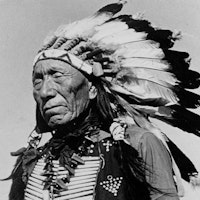In the center grows a mighty flowering tree of life sheltering all the children of one mother and one father. All life is holy.
Black Elk [Heȟáka Sápa]

One Mother and One Father
Topic: Divine Love & Goodness
The sacred hoop of any nation is but one of many that together make the great circle of creation. In the center grows a mighty flowering tree of life sheltering all the children of one mother and one father. All life is holy. People native to this land have long lived by the wisdom of the circle, aware that we are part of the Earth and it is part of us. To harm this Earth, precious to God—is to upset the balance of the circle—is to heap contempt upon its Creator. Therefore, with all our heart and mind, we must restore the balance of the Earth for our grandchildren to the seventh generation.
Heȟáka Sápa, commonly known as Black Elk, was born in December 1863 along the Little Powder River in what is now Wyoming. He was a member of the Oglala Lakota (Sioux) and a second cousin to the renowned war leader Crazy Horse. From a young age, Black Elk experienced profound spiritual visions that would shape his life and destiny. At the age of nine, during a severe illness, he had a vision in which he encountered the Six Grandfathers, spiritual beings who bestowed upon him gifts and powers, including the ability to heal. This vision set him on the path to becoming a wičháša wakȟáŋ, or holy man, a role he embraced throughout his life.
Black Elk's life was marked by significant historical events and personal transformations. He participated in the Battle of the Little Bighorn in 1876 and witnessed the tragic Wounded Knee Massacre in 1890. In the late 1880s, he traveled to Europe with Buffalo Bill's Wild West Show, where he sought to understand the ways of the white people. Upon returning to the United States, he became involved in the Ghost Dance movement, which aimed to restore the Native American way of life. Despite the suppression of this movement, Black Elk continued to serve his people as a healer and spiritual leader, blending traditional Lakota practices with his later conversion to Catholicism in 1904. He became a catechist, teaching Christianity while maintaining his Lakota spiritual beliefs.
Black Elk's legacy extends beyond his lifetime through his contributions to literature and spiritual teachings. His autobiographical accounts, shared with poet John G. Neihardt and anthropologist Joseph Epes Brown, were published in the influential works "Black Elk Speaks" and "The Sacred Pipe." These books have inspired generations and contributed to the revival of Native American culture and spirituality. Black Elk's ability to integrate his Lakota heritage with his Christian faith exemplifies his resilience and adaptability. His life and teachings continue to resonate, symbolizing a bridge between cultures and a testament to the enduring spirit of the Lakota people.
Black Elk Speaks
Wilson, Andrew, editor. World Scripture II. Universal Peace Federation, 2011, p. 155 [Black Elk (Heȟáka Sápa)].

Black Elk [Heȟáka Sápa]
Theme: Divine Father and Mother

About Black Elk’s Quote [Commentary]
Black Elk’s vision of the “mighty flowering tree of life sheltering all the children of one mother and one father” calls us to recognize the sacred unity within creation. The tree, standing at the center of the “great circle of creation,” symbolizes the interconnectedness of all life. It serves as a source of shelter and a spiritual anchor, embodying a divine force that nurtures and sustains all beings. This image reminds us that life, in all its forms, is holy and deserving of reverence.
The mention of “one mother and one father” elevates familial bonds to a universal and divine level. Black Elk’s words suggest the harmonious balance of the masculine and feminine aspects of the Divine in creation. These archetypal roles transcend human distinctions, offering a framework for understanding the Divine’s love and care for all life. Recognizing this sacred lineage, we are invited to live in harmony with one another and the Earth, as members of one interconnected family.
Black Elk’s call to “restore the balance of the Earth” highlights the responsibility we hold for future generations. His vision urges us to act in ways that honor creation and uphold its equilibrium. To live by this wisdom is to embrace a love that safeguards the Earth for “the seventh generation.” By fulfilling this duty, we affirm our place within the circle of creation and align with the divine principles of care and reciprocity Black Elk so beautifully conveys.
Black Elk’s childhood vision [Excerpt describing a childhood vision he had while very ill and near death.]
Black Elk’s Commentary
Resources
Related Quotes
Copyright © 2017 – 2025 LuminaryQuotes.com About Us